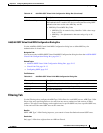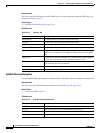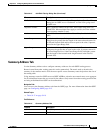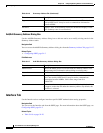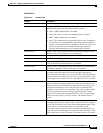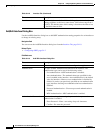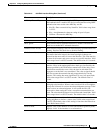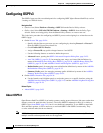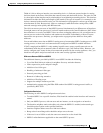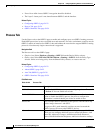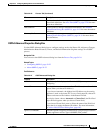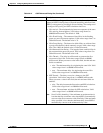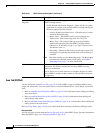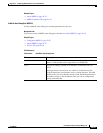
54-22
User Guide for Cisco Security Manager 4.4
OL-28826-01
Chapter 54 Configuring Routing Policies on Firewall Devices
Configuring OSPFv3
Configuring OSPFv3
The OSPFv3 page provides two tabbed panels for configuring OSPF (Open Shortest Path First) version
3 routing on a firewall device.
Navigation Path
• (Device view) Select Platform > Routing > OSPFv3 from the Device Policy selector.
• (Policy view) Select PIX/ASA/FWSM Platform > Routing > OSPFv3 from the Policy Type
selector. Select an existing policy from the Shared Policy selector, or create a new one.
This is the basic procedure for configuring an OSPFv3 process and assigning it to an interface on the
OSPFv3 page:
1. On the Process Tab, page 54-24:
–
Specify which of the two processes you are configuring by choosing Process 1 or Process 2
from the OSPFv3 Process drop-down list.
–
Check Enable OSPFv3 Process.
–
Assign a Process ID; any positive integer between 1 and 65535.
–
Use the following features as needed to define the process:
–
Advanced button, opening the OSPFv3 Advanced Properties Dialog Box, page 54-25.
–
Area Tab (OSPFv3), page 54-28, for managing area, range, and virtual-link definitions, by
means of the Add/Edit Area Dialog Box (OSPFv3), page 54-29, Add/Edit Range Dialog Box
(OSPFv3), page 54-30, and Add/Edit Virtual Link Dialog Box (OSPFv3), page 54-31.
–
Redistribution panel, for managing route redistribution definitions by means of the Add/Edit
Redistribution Dialog Box (OSPFv3), page 54-32.
–
Summary Prefix panel, for managing summary-prefix definitions by means of the Add/Edit
Summary Prefix Dialog Box (OSPFv3), page 54-34.
2. On the OSPFv3 Interface Tab, page 54-34:
a. Use the Interface and Neighbor panels to assign the process to a specific interface, using the
Add/Edit Interface Dialog Box (OSPFv3), page 54-35 and the Add/Edit Neighbor Dialog Box
(OSPFv3), page 54-38.
Related Topics
• About OSPFv3, page 54-22
About OSPFv3
Open Shortest Path First (OSPF) is an interior gateway routing protocol that uses link states rather than
distance vectors for path selection. Version 3 is basically OSPFv2 enhanced for IPv6. It is similar to
OSPFv2 (see About OSPF, page 54-2), but it is not backward compatible. To use OSPF to route both
IPv4 and IPv6v packets, it will be necessary to run both OSPFv2 and OSPFv3 concurrently. They
co-exist with each other, but do not interact.
Note OSPFv3 is supported on ASA 9.0+ devices operating in single-context, routed mode only. That is,
multiple contexts and transparent mode are not supported.




